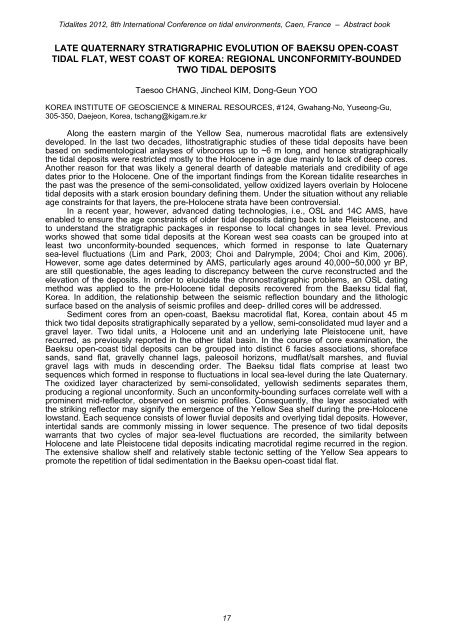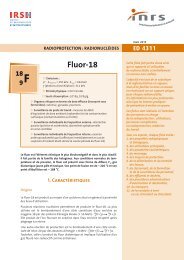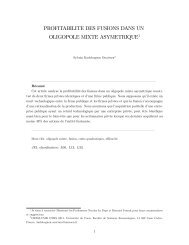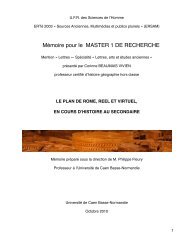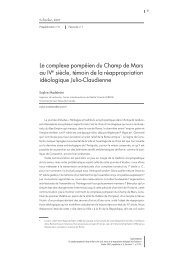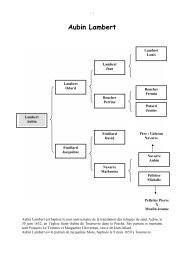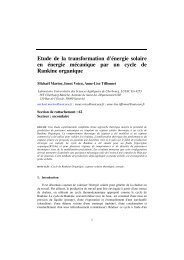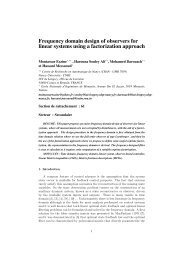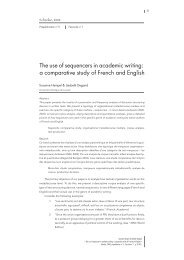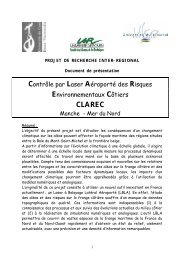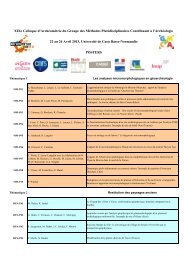programme tuesday, july, 31 - Université de Caen Basse Normandie
programme tuesday, july, 31 - Université de Caen Basse Normandie
programme tuesday, july, 31 - Université de Caen Basse Normandie
You also want an ePaper? Increase the reach of your titles
YUMPU automatically turns print PDFs into web optimized ePapers that Google loves.
Tidalites 2012, 8th International Conference on tidal environments, <strong>Caen</strong>, France – Abstract book<br />
LATE QUATERNARY STRATIGRAPHIC EVOLUTION OF BAEKSU OPEN-COAST<br />
TIDAL FLAT, WEST COAST OF KOREA: REGIONAL UNCONFORMITY-BOUNDED<br />
TWO TIDAL DEPOSITS<br />
Taesoo CHANG, Jincheol KIM, Dong-Geun YOO<br />
KOREA INSTITUTE OF GEOSCIENCE & MINERAL RESOURCES, #124, Gwahang-No, Yuseong-Gu,<br />
305-350, Daejeon, Korea, tschang@kigam.re.kr<br />
Along the eastern margin of the Yellow Sea, numerous macrotidal flats are extensively<br />
<strong>de</strong>veloped. In the last two <strong>de</strong>ca<strong>de</strong>s, lithostratigraphic studies of these tidal <strong>de</strong>posits have been<br />
based on sedimentological anlayses of vibrocores up to ~6 m long, and hence stratigraphically<br />
the tidal <strong>de</strong>posits were restricted mostly to the Holocene in age due mainly to lack of <strong>de</strong>ep cores.<br />
Another reason for that was likely a general <strong>de</strong>arth of dateable materials and credibility of age<br />
dates prior to the Holocene. One of the important findings from the Korean tidalite researches in<br />
the past was the presence of the semi-consolidated, yellow oxidized layers overlain by Holocene<br />
tidal <strong>de</strong>posits with a stark erosion boundary <strong>de</strong>fining them. Un<strong>de</strong>r the situation without any reliable<br />
age constraints for that layers, the pre-Holocene strata have been controversial.<br />
In a recent year, however, advanced dating technologies, i.e., OSL and 14C AMS, have<br />
enabled to ensure the age constraints of ol<strong>de</strong>r tidal <strong>de</strong>posits dating back to late Pleistocene, and<br />
to un<strong>de</strong>rstand the stratigraphic packages in response to local changes in sea level. Previous<br />
works showed that some tidal <strong>de</strong>posits at the Korean west sea coasts can be grouped into at<br />
least two unconformity-boun<strong>de</strong>d sequences, which formed in response to late Quaternary<br />
sea-level fluctuations (Lim and Park, 2003; Choi and Dalrymple, 2004; Choi and Kim, 2006).<br />
However, some age dates <strong>de</strong>termined by AMS, particularly ages around 40,000~50,000 yr BP,<br />
are still questionable, the ages leading to discrepancy between the curve reconstructed and the<br />
elevation of the <strong>de</strong>posits. In or<strong>de</strong>r to elucidate the chronostratigraphic problems, an OSL dating<br />
method was applied to the pre-Holocene tidal <strong>de</strong>posits recovered from the Baeksu tidal flat,<br />
Korea. In addition, the relationship between the seismic reflection boundary and the lithologic<br />
surface based on the analysis of seismic profiles and <strong>de</strong>ep- drilled cores will be addressed.<br />
Sediment cores from an open-coast, Baeksu macrotidal flat, Korea, contain about 45 m<br />
thick two tidal <strong>de</strong>posits stratigraphically separated by a yellow, semi-consolidated mud layer and a<br />
gravel layer. Two tidal units, a Holocene unit and an un<strong>de</strong>rlying late Pleistocene unit, have<br />
recurred, as previously reported in the other tidal basin. In the course of core examination, the<br />
Baeksu open-coast tidal <strong>de</strong>posits can be grouped into distinct 6 facies associations, shoreface<br />
sands, sand flat, gravelly channel lags, paleosoil horizons, mudflat/salt marshes, and fluvial<br />
gravel lags with muds in <strong>de</strong>scending or<strong>de</strong>r. The Baeksu tidal flats comprise at least two<br />
sequences which formed in response to fluctuations in local sea-level during the late Quaternary.<br />
The oxidized layer characterized by semi-consolidated, yellowish sediments separates them,<br />
producing a regional unconformity. Such an unconformity-bounding surfaces correlate well with a<br />
prominent mid-reflector, observed on seismic profiles. Consequently, the layer associated with<br />
the striking reflector may signify the emergence of the Yellow Sea shelf during the pre-Holocene<br />
lowstand. Each sequence consists of lower fluvial <strong>de</strong>posits and overlying tidal <strong>de</strong>posits. However,<br />
intertidal sands are commonly missing in lower sequence. The presence of two tidal <strong>de</strong>posits<br />
warrants that two cycles of major sea-level fluctuations are recor<strong>de</strong>d, the similarity between<br />
Holocene and late Pleistocene tidal <strong>de</strong>posits indicating macrotidal regime recurred in the region.<br />
The extensive shallow shelf and relatively stable tectonic setting of the Yellow Sea appears to<br />
promote the repetition of tidal sedimentation in the Baeksu open-coast tidal flat.<br />
17


